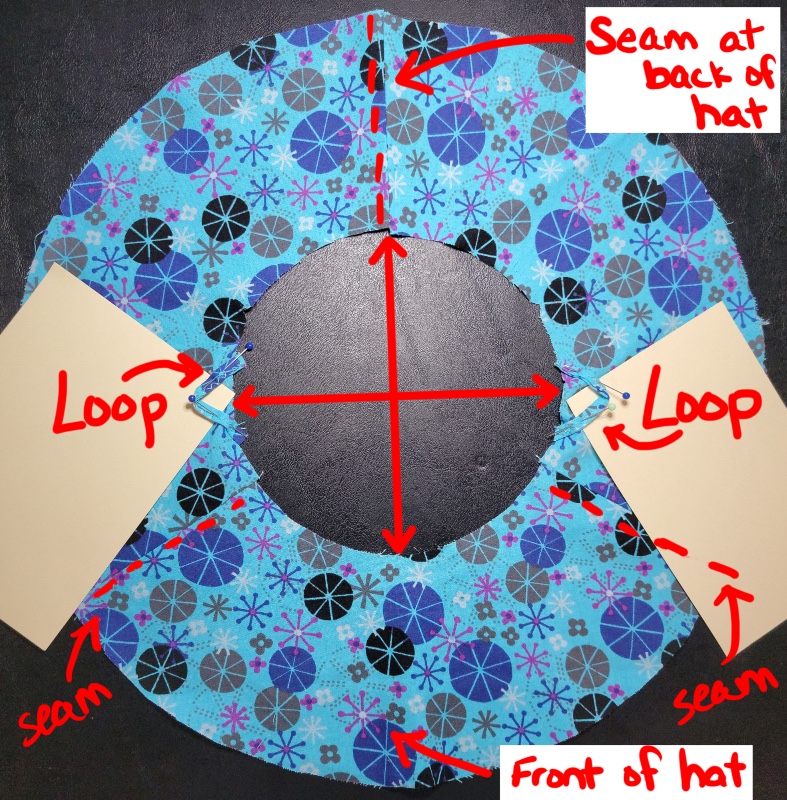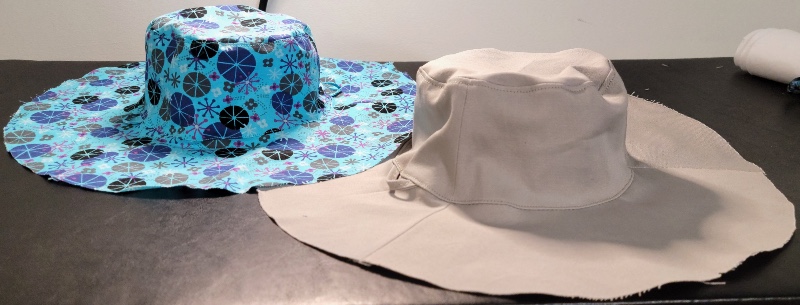
I designed a couple of fleece animals hats for my kids last year. In the time since then, we have gotten stopped by strangers every time we go out to a store. Everyone loves these hats! They can be a bit work intensive, particularly the embroidery for the eyes and nose, but the finished product is absolutely worth it.
This fox hat pattern was designed for my 8 year old, whose head is 21.5″ around. Thanks to the flexible stretch of the fleece, this finished hat will fit kids from about age 4 through age 10. After age 10, the hat can still be worn, but it starts to get a bit snug and/or short.
Hat Sewing Instructions
Step 1: Cut the fleece pieces out
Click here to download the hat pattern. It will download as a 4-page PDF. Go ahead and cut out the pattern pieces. You’ll need to tape together the brim pattern pieces (the long, skinny piece).

I usually like to use no-pill fleece for my hats, although with this particular one I chose a more furry-feeling reddish-brown fleece. I stuck with normal no-pilling fleece for the black and white pieces, though.
From brownish-red felt: Cut 2 front pieces, 2 back pieces, 4 ear flaps, and 4 outer fox ears. Make sure the fox’s ears are cut as 2 mirrored pairs.
From white felt: Cut 2 inner fox ears, making sure they are mirrored. Also cut 1 face piece on the fold.
From black felt: Cut 2 brim pieces on a fold, 2 eyes, and 1 nose. make sure the eyes are a mirrored pair.
Step 2: Sew the face and ear pieces

Put white thread into your sewing machine.
Position and pin the white face to the main front piece, such that there is 1″ between the white outer eye points and the edge of the main brown piece. There should also be 1″ between the bottom of the white face and the bottom of the main brown piece. (See the picture.)

Sew around the edges of the white face with a zigzag stitch, using white thread. I used a width of 5 and a stitch length of 3.
Sew the white inner ears to the fronts of the outer ears with the same zigzag stitch. (See picture.)
Step 3: Sew the eye and nose pieces

Switch your thread color to black in the sewing machine.
Position and pin the black eye pieces onto the white face. Sew around the edges with a zigzag stitch, using black thread. I use a width of 5 and length 3 for most of the eye, but I narrow the width to a 3 at the outer points to help them taper nicely. (See picture.)
Step 5: Position the black nose onto the face and sew it into place with zigzag stitch.
Step 4: Hand embroider the facial features
Transfer the embroidery pattern to the fox face using your preferred method. I like to use water-soluble stabilizer. I use an ultra-washable Crayola marker to draw the pattern onto the stabilizer. Then I pin the stabilizer to the hat for stitching.
I embroider the face as follows:
Nostrils: First do a vertical satin stitch with light grey embroidery floss, 4 strands. Then underline the nostrils with split stitch, using 2 strands of white.
Nose detail: The long white line curving across the top of the nose, and the white line that goes vertically between the nostrils: Do both of these with 2 strands of white floss in split stitch.
Eyes – white sections: Sew the white highlights in the eyes and the white edges around the iris. Do both of these with 4 strands of white floss in satin stitch.
Eyes – iris: Use 2 strands of greenish-yellow floss and 1 strand of orange-brown floss. Stitch the iris with satin stitch. Your stitches should radiate out from the center, as shown in the picture below.
Under-eye outline: With 2 strands of black, sew a split stitch along the line just below both eyes.
Mouth: Sew the mouth with 4 strands of black in split stitch.
Tongue: With 4 strands of pink or red floss, sew the tongue with satin stitch.

When the embroidery is finished, dissolve the water-soluble stabilizer if you used any. Let the piece air dry overnight. Don’t try to put it into a dryer, because you risk the fleece edges coming apart.
Step 5: Sew the fox ears and the ear flaps

With right sides together, sew the fox ear fronts and backs together along the tops and sides with 1/4″ seam. Leave the bottom edge open. (Fox ears are the ones in the top of the picture.)
Also sew the ear flap fronts and backs together with right sides together, leaving the flat top edge open. (The ear flaps are the ones in the bottom of the picture.)
Turn everything right side out.
Step 6: Sew the outer pieces together

With right sides together, sew the outer front piece and outer back piece together along the sides and top with a 1/4″ seam. Leave the ear edges open, and leave the bottom open. I marked the edges you should sew with green in the picture.
(Warning: Make sure you’re sewing a BACK piece to your front embroidered piece. I once accidentally sewed the front liner to the front embroidered piece, and the subsequent seam ripping I had to do was the pits.)
Next, insert the fox ears inside the outer hat so that the ear fronts and the embroidered face are facing each other. Make sure the left ear and right ear are on the correct sides, so they point out and away from each other. See the pink arrows in the picture for guidance.

Once the ears are inserted, their bottom edges should stick out about 1/4″ past the hat’s opening. Sew in place 1/2″ from the edge of the ears (which is 1/4″ from the edge of the hat opening). You may need a long stitch length due to the number of layers for this stitching. I use length 4.
Confirm the stitching caught all layers and that no restitching is needed. Once that is confirmed, trim the excess seam from the ear bottoms. It should look like this after trimming.
Turn the outer hat right side out.
Step 7: Piece together the hat liner

With their right sides together, sew the front liner to the back liner. IMPORTANT: This time, you are sewing different edges than you did with the outer pieces! Only sew the sides and the ear edges together. Leave the top of the head open, and leave the bottom edge open. I’ve marked the edges to sew with green in the picture.
Step 8: Piece together the brim and ear flaps
With right sides together, pin the brim to the brim liner along their bottom edge. Insert the ear flaps between the brim and liner, as shown in the picture. Use the notches to line up the ear flaps where they belong. The ear flaps should be positioned so that they stick out 1/4″ past the edge of the brim seam.

Sew everything together along the brim bottom edge, as shown in the picture above. Use a wide zigzag stitch, so the brim keeps its stretchiness. I used a zigzag with width 3, length 4.
Step 9: Sew the brim into a circle

Next, open the seam you just stitched, so that the brim and brim liner are separated and lying flat. Fold the whole thing in half lengthwise, bringing together the short ends with right sides facing. Sew the ends together 1/4″ from the edge with a straight stitch, as shown in the picture here.
Step 10: Attach the brim to the hat
With right sides together, pin the brim to the bottom edge of the outer hat, lining up notches and seams. The brim seam from step 9 should line up with the hat’s back center notch. Sew all the way around with a zigzag stitch 1/4″ from the edge. I used zigzag width 3, length 4.
At this point, the hat should look like this with the brim unfolded all the way down:

Step 11: Attach the liner to the hat

With the hat liner inside out, pull the liner over the outer hat and line up the brim edge with the liner’s bottom edge. The hat and its liner should be right sides together.
You can pull the hat’s ears up through the hole in the top of the liner to help the fabric lay flat. (See picture.) Pin the brim to the liner, lining up notches and seams.
Sew around the hat with a zigzag stitch 1/4″ from edge, attaching the brim to the liner. I used zigzag width 3, length 4.
Step 12: Close up the liner

Pull the hat completely right side out. Push and pull on corners to help the seams flatten out. It will look like this.

Now double check that there are NO MORE PINS hiding in the fabric!! Once the coast is clear, fold the edges of the liner opening under 1/4″ and sew together as close to the edge as possible. Give a light tug after sewing to make sure the liner is completely closed and that no little holes remain.
Step 13: Finishing touches

Push the liner up inside the hat. At this point, you can call the project finished and get on with life, or you can do the final step that I like to do to secure the liner inside the hat.
With a regular sharps needle and black thread, I throw a couple hidden stitches right on top of the brim seam at the front center and back center.
Phew, you did it! I think my favorite part of this hat sewing pattern is how easy it is to tweak it into just about any animal. Simply change the eye, nose, and ear shapes, and use a different color felt. I’ve made a few birthday presents for local friends’ kids, where I even tailored the hat to look like their pet cat or dog. So much fun!
Even our family dog approves of the fox hat!










































